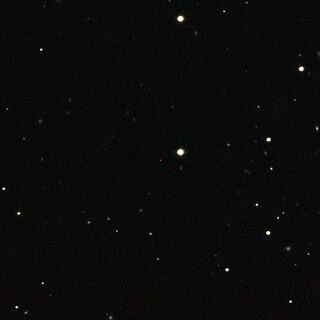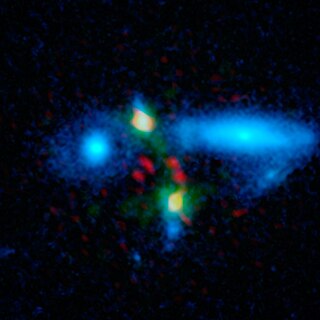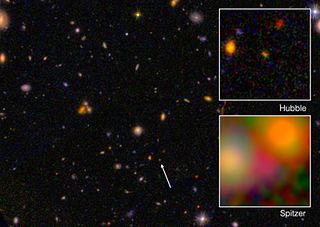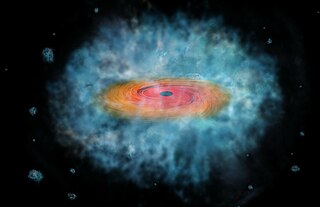
A quasar is an extremely luminous active galactic nucleus (AGN). It is sometimes known as a quasi-stellar object, abbreviated QSO. The emission from an AGN is powered by a supermassive black hole with a mass ranging from millions to tens of billions of solar masses, surrounded by a gaseous accretion disc. Gas in the disc falling towards the black hole heats up and releases energy in the form of electromagnetic radiation. The radiant energy of quasars is enormous; the most powerful quasars have luminosities thousands of times greater than that of a galaxy such as the Milky Way. Quasars are usually categorized as a subclass of the more general category of AGN. The redshifts of quasars are of cosmological origin.

The timeline of the early universe outlines the formation and subsequent evolution of the Universe from the Big Bang to the present day. An epoch is a moment in time from which nature or situations change to such a degree that it marks the beginning of a new era or age.

In 1944, Walter Baade categorized groups of stars within the Milky Way into stellar populations. In the abstract of the article by Baade, he recognizes that Jan Oort originally conceived this type of classification in 1926.

The observable universe is a ball-shaped region of the universe consisting of all matter that can be observed from Earth or its space-based telescopes and exploratory probes at the present time; the electromagnetic radiation from these objects has had time to reach the Solar System and Earth since the beginning of the cosmological expansion. Initially, it was estimated that there may be 2 trillion galaxies in the observable universe. That number was reduced in 2021 to only several hundred billion based on data from New Horizons. Assuming the universe is isotropic, the distance to the edge of the observable universe is roughly the same in every direction. That is, the observable universe is a spherical region centered on the observer. Every location in the universe has its own observable universe, which may or may not overlap with the one centered on Earth.
In physical cosmology, a protogalaxy, which could also be called a "primeval galaxy", is a cloud of gas which is forming into a galaxy. It is believed that the rate of star formation during this period of galactic evolution will determine whether a galaxy is a spiral or elliptical galaxy; a slower star formation tends to produce a spiral galaxy. The smaller clumps of gas in a protogalaxy form into stars.

In the fields of Big Bang theory and cosmology, reionization is the process that caused electrically neutral atoms in the universe to reionize after the lapse of the "dark ages".

In astronomical spectroscopy, the Lyman-alpha forest is a series of absorption lines in the spectra of distant galaxies and quasars arising from the Lyman-alpha electron transition of the neutral hydrogen atom. As the light travels through multiple gas clouds with different redshifts, multiple absorption lines are formed.

In astronomy, a Lyman-alpha blob (LAB) is a huge concentration of a gas emitting the Lyman-alpha emission line. LABs are some of the largest known individual objects in the Universe. Some of these gaseous structures are more than 400,000 light years across. So far they have only been found in the high-redshift universe because of the ultraviolet nature of the Lyman-alpha emission line. Since Earth's atmosphere is very effective at filtering out UV photons, the Lyman-alpha photons must be redshifted in order to be transmitted through the atmosphere.
The chronology of the universe describes the history and future of the universe according to Big Bang cosmology.

UDFy-38135539 is the Hubble Ultra Deep Field (UDF) identifier for a galaxy which was calculated as of October 2010 to have a light travel time of 13.1 billion years with a present proper distance of around 30 billion light-years.

The SSA22 Protocluster, also known as EQ J221734.0+001701, is a galaxy protocluster located at z=3.1 in the SSA 22 region. It is located at 22h 17m 34.0s +00° 17′ 01″ and was originally discovered in 1998.

ULAS J1120+0641 was the most distant known quasar when discovered in 2011, surpassed in 2017 by ULAS J1342+0928. ULAS J1120+0641 was the first quasar discovered beyond a redshift of z = 7. Its discovery was reported in June 2011.

HXMM01, known more formally as 1HERMES S250 J022016.5−060143, is a starburst galaxy located in the northwestern portion of the constellation Cetus. Discovered in 2013 by a team at the University of California, Irvine, it was discovered that HXMM01 is actually still forming from its two parent galaxies as part of the "brightest, most luminous and most gas-rich submillimeter-bright galaxy merger known." When the merger is complete, HXMM01 will rapidly evolve to become a giant elliptical galaxy with a mass about four times that of the Milky Way. As of 2013, HXMM01 has been observed to form about 2,000 M☉ of stars every year, with an efficiency ten times greater than that of typical galaxies and far more than the Milky Way's 0.68–1.45 M☉ per year.

Green bean galaxies (GBGs) are very rare astronomical objects that are thought to be quasar ionization echos. They were discovered by Mischa Schirmer and colleagues R. Diaz, K. Holhjem, N.A. Levenson, and C. Winge. The authors report the discovery of a sample of Seyfert-2 galaxies with ultra-luminous galaxy-wide narrow-line regions (NLRs) at redshifts z=0.2-0.6.

Lyman-alpha blob 1 (LAB-1) is a giant cosmic cloud of gas located in the constellation of Aquarius, approximately 11.5 billion light-years from Earth with a redshift (z) of 3.09. It was discovered unexpectedly in 2000 by Charles Steidel and colleagues, who were surveying for high-redshift galaxies using the 200 inch Hale telescope at the Palomar Observatory. The researchers had been investigating the abundance of galaxies in the young Universe when they came across two objects which would become known as Lyman-alpha blobs—huge concentrations of gases emitting the Lyman-alpha emission line of hydrogen.

EGSY8p7 (EGSY-2008532660) is a distant galaxy in the constellation of Boötes, with a spectroscopic redshift of z = 8.68, a light travel distance of 13.2 billion light-years from Earth. Therefore, at an age of 13.2 billion years, it is observed as it existed 570 million years after the Big Bang, which occurred 13.8 billion years ago, using the W. M. Keck Observatory. In July 2015, EGSY8p7 was announced as the oldest and most-distant known object, surpassing the previous record holder, EGS-zs8-1, which was determined in May 2015 as the oldest and most distant object. In March 2016, Pascal Oesch, one of the discoverers of EGSY8p7, announced the discovery of GN-z11, an older and more distant galaxy.

TON 618 is a hyperluminous, broad-absorption-line, radio-loud quasar and Lyman-alpha blob located near the border of the constellations Canes Venatici and Coma Berenices, with the projected comoving distance of approximately 18.2 billion light-years from Earth. It possesses one of the most massive black holes ever found, at 40.7 billion M☉.

Direct collapse black holes (DCBHs) are high-mass black hole seeds, putatively formed within the redshift range z=15–30, when the Universe was about 100–250 million years old. Unlike seeds formed from the first population of stars (also known as Population III stars), direct collapse black hole seeds are formed by a direct, general relativistic instability. They are very massive, with a typical mass at formation of ~105 M☉. This category of black hole seeds was originally proposed theoretically to alleviate the challenge in building supermassive black holes already at redshift z~7, as numerous observations to date have confirmed.
F200DB-045 is a candidate high-redshift galaxy, with an estimated redshift of approximately z = 20.4, corresponding to 168 million years after the Big Bang. If confirmed, it would be one of the earliest and most distant known galaxies observed.
















